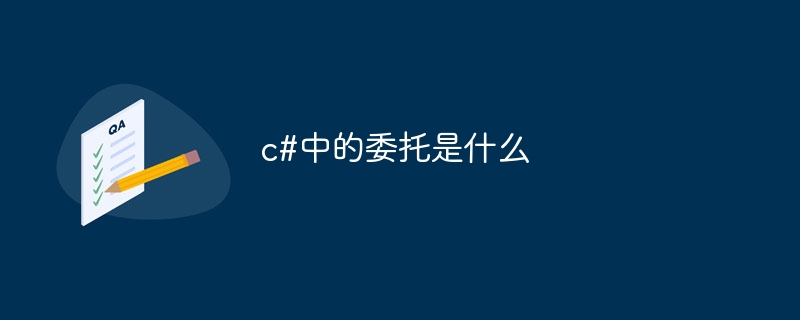What is a delegate in c#
A delegate is a type-safe reference pointing to a method in C# and has the following main functions: allowing the method to execute in an asynchronous or event-driven mode. Provides code modularization and reuse mechanisms. Implement callback function.

Delegates in C
#A delegate is a type-safe reference to a method. It allows methods to be passed as parameters to other methods, thus enabling code reusability and modularity.
Function:
The main function of the delegate is:
- Allow methods to execute in asynchronous or event-driven mode.
- Provides a mechanism to modularize and reuse code.
- Implement the callback function, that is, execute specific code when an event occurs.
Syntax:
The syntax of delegation is as follows:
<code>public delegate <return_type> <delegate_name>(<parameter_list>);</code>
Among them:
- ##< ;return_type>
: The type returned by the delegate, which can be any type, including void. : The name of the delegate.: The parameter list of the delegate method.
Usage:
To use a delegate, you need to perform the following steps:- Declare the delegate type.
- Create a delegate instance that points to the method to be called.
- Call the delegate instance just like calling a normal method.
Example:
Here is an example of using a delegate:// 定义委托类型 public delegate int CalculateDelegate(int a, int b); // 创建委托实例 CalculateDelegate calculate = (a, b) => a + b; // 调用委托 int result = calculate(10, 20);
CalculateDelegate The delegate type is declared as a method that accepts two integers and returns an integer. Then, a delegate instance calculate is created that points to an anonymous method that adds two integers. Finally, the calculate delegate instance is called, adding the two integers and storing them in the result variable.
The above is the detailed content of What is a delegate in c#. For more information, please follow other related articles on the PHP Chinese website!

Hot AI Tools

Undresser.AI Undress
AI-powered app for creating realistic nude photos

AI Clothes Remover
Online AI tool for removing clothes from photos.

Undress AI Tool
Undress images for free

Clothoff.io
AI clothes remover

Video Face Swap
Swap faces in any video effortlessly with our completely free AI face swap tool!

Hot Article

Hot Tools

Notepad++7.3.1
Easy-to-use and free code editor

SublimeText3 Chinese version
Chinese version, very easy to use

Zend Studio 13.0.1
Powerful PHP integrated development environment

Dreamweaver CS6
Visual web development tools

SublimeText3 Mac version
God-level code editing software (SublimeText3)

Hot Topics
 1665
1665
 14
14
 1424
1424
 52
52
 1322
1322
 25
25
 1270
1270
 29
29
 1250
1250
 24
24
 Active Directory with C#
Sep 03, 2024 pm 03:33 PM
Active Directory with C#
Sep 03, 2024 pm 03:33 PM
Guide to Active Directory with C#. Here we discuss the introduction and how Active Directory works in C# along with the syntax and example.
 Random Number Generator in C#
Sep 03, 2024 pm 03:34 PM
Random Number Generator in C#
Sep 03, 2024 pm 03:34 PM
Guide to Random Number Generator in C#. Here we discuss how Random Number Generator work, concept of pseudo-random and secure numbers.
 C# Data Grid View
Sep 03, 2024 pm 03:32 PM
C# Data Grid View
Sep 03, 2024 pm 03:32 PM
Guide to C# Data Grid View. Here we discuss the examples of how a data grid view can be loaded and exported from the SQL database or an excel file.
 Factorial in C#
Sep 03, 2024 pm 03:34 PM
Factorial in C#
Sep 03, 2024 pm 03:34 PM
Guide to Factorial in C#. Here we discuss the introduction to factorial in c# along with different examples and code implementation.
 The difference between multithreading and asynchronous c#
Apr 03, 2025 pm 02:57 PM
The difference between multithreading and asynchronous c#
Apr 03, 2025 pm 02:57 PM
The difference between multithreading and asynchronous is that multithreading executes multiple threads at the same time, while asynchronously performs operations without blocking the current thread. Multithreading is used for compute-intensive tasks, while asynchronously is used for user interaction. The advantage of multi-threading is to improve computing performance, while the advantage of asynchronous is to not block UI threads. Choosing multithreading or asynchronous depends on the nature of the task: Computation-intensive tasks use multithreading, tasks that interact with external resources and need to keep UI responsiveness use asynchronous.
 Patterns in C#
Sep 03, 2024 pm 03:33 PM
Patterns in C#
Sep 03, 2024 pm 03:33 PM
Guide to Patterns in C#. Here we discuss the introduction and top 3 types of Patterns in C# along with its examples and code implementation.
 Prime Numbers in C#
Sep 03, 2024 pm 03:35 PM
Prime Numbers in C#
Sep 03, 2024 pm 03:35 PM
Guide to Prime Numbers in C#. Here we discuss the introduction and examples of prime numbers in c# along with code implementation.
 How to change the format of xml
Apr 03, 2025 am 08:42 AM
How to change the format of xml
Apr 03, 2025 am 08:42 AM
There are several ways to modify XML formats: manually editing with a text editor such as Notepad; automatically formatting with online or desktop XML formatting tools such as XMLbeautifier; define conversion rules using XML conversion tools such as XSLT; or parse and operate using programming languages such as Python. Be careful when modifying and back up the original files.




